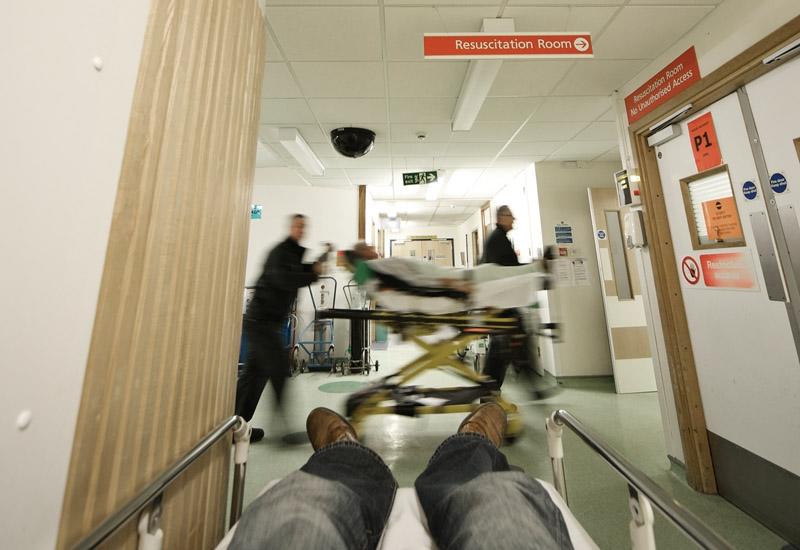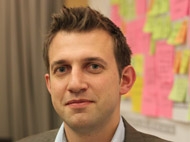FEATURE1 January 2012
All MRS websites use cookies to help us improve our services. Any data collected is anonymised. If you continue using this site without accepting cookies you may experience some performance issues. Read about our cookies here.
FEATURE1 January 2012
Violence is always a problem in A&E departments, and never more so than at Christmas. Robert Bain meets the ethnographers who went to see for themselves.

Most researchers look forward to a break from work over the festive season. But a year ago a team from social research agency ESRO and the Design Council gave up their Christmas and New Year to immerse themselves in the one place we all hope not to end up: A&E.
The assignment was the beginning of a year-long project aiming to reduce violence and aggression in A&E departments. NHS hospital staff deal with more than 150 such incidents every day, and it doesn’t get busier or rowdier than at Christmas and New Year. As well as the obvious impact of this on safety and staff morale, it’s a problem that is estimated to cost the taxpayer £69m a year – the equivalent of the salaries of 4,500 nurses.
“I developed a lot of respect for the people who work in A&E. They put up with so much and delivered so much for patients”
Chris Howroyd, Design Council

In the past, information on violence in A&E has come largely from incident reports and staff surveys, but this time the Department of Health wanted to try a different tack. Interviews, extensive desk research and 300 hours of ethnography in the run-up to Christmas fed into a design contest to come up with ways to deal with the problem, encompassing everything from signage to the clothes staff wear to procedures at reception.
To get an understanding of the true nature of the problem researchers shadowed staff at hospitals in London, Southampton and Chesterfield, working consecutive days to follow patients through the whole A&E process. The three trusts involved deal with nearly 400 assaults a year.
Even though Christmas and New Year is their toughest period, the staff at the hospitals all agreed to be observed for the research. As for patients, consent had to be sought ad hoc, but in the event very few people declined to take part.
Violent night
Chris Howroyd, health programme manager at the Design Council, started his shift at 4am on News Year’s Day. He believes ethnographic research like this is ideal for design challenges. “I can’t think of another way you can do it,” he said. “It’s the only way in which a true picture can be developed through the eyes of the user.”
“Ethnography enables a whole swathe of other kinds of data than what you’d get by doing an interview or focus group”
Becky Rowe, ESRO

Howroyd has been working with the Department of Health for several years on what he describes as “intractable, knotty issues” – including hospital infections and dignity of patients. “There’s a common misconception that design is just about aesthetics – it’s not,” he says. “It can cover information design, process design, environmental design, spatial design. Everything from a paperclip to a skyscraper, as well as intangible stuff.”
Howroyd is no stranger to hospitals. He’s the son of a nurse, has been working on healthcare issues for the past five years, and as a goalkeeper for a football team, has periodically found himself seeking A&E treatment for injuries – most recently a dislocated thumb. But nothing prepared him for working a shift there at Christmas.
“I really don’t know how to describe it,” says Howroyd. “I developed a lot of respect for those people who work in A&E. They put up with so much and delivered so much for the benefit of those patients who come in, day in, day out.”
Becky Rowe led the team from ESRO that handled the ethnography. The power of ethnographic research, she says, is in going beyond what people are able to put into words. “If you ask people about this issue they’ll tell you violence and aggression are caused by people who are drunk, or people who are substance abusers, that kind of thing,” she said. “That’s true to some degree, but this research uncovered a huge amount of violence and aggression that challenged that assumption.
“Ethnography enables a whole swathe of other kinds of data than what you’d get by doing an interview or a focus group – it enables analysis of how people use space, analysis of interactions between people. It enables you to build up a perspective over time about what has caused people’s behaviour. Things that you would never think were related to the actual issue but which all work towards triggering the behaviour.”
The staff surveys and reports that hospitals relied on for information about cases of aggression only told part of the story
One of the things Rowe realised was that the staff surveys and reports that hospitals relied on only told part of the story about cases of aggression. They underreported incidents and tended only to include the worst examples, which then became part of the discourse around violence among staff. In one hospital, staff kept talking about the risk of patients jumping over the reception desk to attack them – something which had happened just once, five years earlier, but had clearly become rooted in the hospital’s folklore.
Meanwhile smaller incidents of aggression and minor violence were occurring much more frequently and adding up to create the feeling of a hostile environment – but staff often didn’t bother to record them.
Incident reports also tended to be one-sided and not consider the motivations that might make someone lose their temper. “You won’t find an incident report saying, ‘They were waiting a long time and they had a small baby with them,’ or ‘They perceived us to be inefficient,’” says Rowe. “They’ll say, ‘That person was anti-social.’” As a result ESRO’s ethnographic research was able to “fill a massive data gap”.
Watch and learn
Watching how patients and staff behave in A&E helped to challenge assumptions about how and why violence breaks out. “We saw all sorts of people – people you might not expect – being violent and aggressive,” said Rowe. A lot of incidents involved concerned relatives and friends rather than patients themselves, and alcohol was just one of numerous things that could come together to make a situation flare up.
Other common triggers included the intense emotions that arise in A&E, the clash of people forced together by extreme circumstances, the inhospitable (and sometimes unsafe) surroundings, tired staff, inefficiency or perceived inefficiency, baffling rules and endless waiting.
Perception of inefficiency often manifests itself in accusations of queue jumping when some patients are seen before others (often for perfectly sensible reasons such as the severity of their injuries or the availability of specialist staff). At the same time some patients might appear to be more badly hurt than they are, creating an impression that sick people are being neglected if others are treated first.
Lack of information was one of the things that bred anxiety and frustration, with patients often not knowing where they were in the treatment process, when they could expect to be seen or what was going to happen to them.
“As a patient coming in through the walk-in entrance, you can’t see that five ambulances of people who’ve just been in a very serious car accident have just come in,” says Rowe. “If you see a staff member on the phone, perhaps smiling, it might look like they’re just chatting. But the nurses and doctors have a very good relationship with the ambulance crews, and that might be a very serious phone call. They might be receiving an ambulance with someone with a very serious injury. If you don’t realise that’s a serious call, that can make you more and more stressed.”
The human touch
From briefs developed out of the findings of the ethnographic research, designers, manufacturers and technologists submitted ideas to an innovation contest run by the Design Council. The winner was a consortium led by design agency PearsonLloyd, whose proposed solutions emphasised the importance of a human approach and covered improvements to the arrival experience, the waiting experience, better information and ways of helping staff to cope (see box below).
The solutions are designed to be cheap and simple, with Design Council CEO David Kester describing them as a “low-cost solution to a high-cost problem”. And whereas previous initiatives have been reactive these proposals are about prevention. “The solutions are common sense,” says Howroyd, “and you have to ask yourself why they have not been implemented before.”
The idea was to come up with suggestions that any hospital in the country could implement, whether it was built in 1895 or 1995. Something as simple as a dimmer switch could make a noticeable difference, says Rowe. “At one of the trusts that we spent time in, the receptionist took it upon herself to turn the lights down at night time. So it’s four in the morning and the hospital is incredibly bright and inhospitable. When she turned the light down you immediately saw everyone go, ‘Ooh, that’s a bit better.’ People are already on high alert when they’re in A&E – it’s very hard to relax in that environment. So anything that you can do to enable people to relax just a little, it’s one less thing to make you feel anxious.”
Researchers also looked at the impact of security measures like CCTV, stab-proof vests, lockdown systems and security guards. The instinctive reaction to the risk of violence can be to “batten down the hatches” says Rowe. But in fact it’s possible to prevent a lot of problems much earlier in the process by improving the patient experience, rather than implementing measures that make staff and patients feel that violence is inevitable.
Rowe and Howroyd agree that the involvement of A&E staff in the research was vital. Rowe says they were “incredibly supportive” during the fieldwork and Howroyd describes the contributions of frontline staff as “pivotal” in the design process. Researchers also spoke to professionals in other settings where violence and aggression is an issue, including prisons, airports and courts.
Of course, the research highlighted lots of issues that fell beyond the remit of this project, and had to be parked. “We can’t do very much about someone showing up at A&E who has had 15 pints and wants a fight, that’s a societal issue,” says Howroyd. The same goes for issues like the actual speed and efficiency of treatment in A&E, mental health-related problems and staff’s fear of litigation.

Full details of the design solutions can be found at
www.designcouncil.org.uk/AandE
Designs for life
The 153-page report setting out how the design solutions can be put into practice is being sent to every NHS Trust. The cost of implementing them is estimated at around £60,000 per trust, and the effectiveness of the proposals will now be evaluated in three trusts, chosen from twelve that volunteered. Howroyd is hoping to see “significant” reductions in cases of violence and aggression.
Rowe says the project shows that ethnography doesn’t have to be slow – one of the main barriers to clients adopting the method. “We did 300 hours of fieldwork,” she said. “That sounds like a long, long time, but the project was commissioned in December and the findings were delivered by the end of January.” As for cost, the ethnographic research accounted for less than 10% of the £450,000 spent on the initiative as a whole.
The complexity of the issues that public sector research clients have to grapple with means they have been quicker to embrace ethnography, Rowe believes. “We hear from public sector clients all the time that they’ve focus-grouped an issue to death and they haven’t managed to get further forward. The public sector have taken huge strides ahead of the private sector in some situations in embracing ethnography as a technique, and there’s a huge opportunity for the commercial sector to think a bit more broadly about how they do research and what value this could have.”
0 Comments